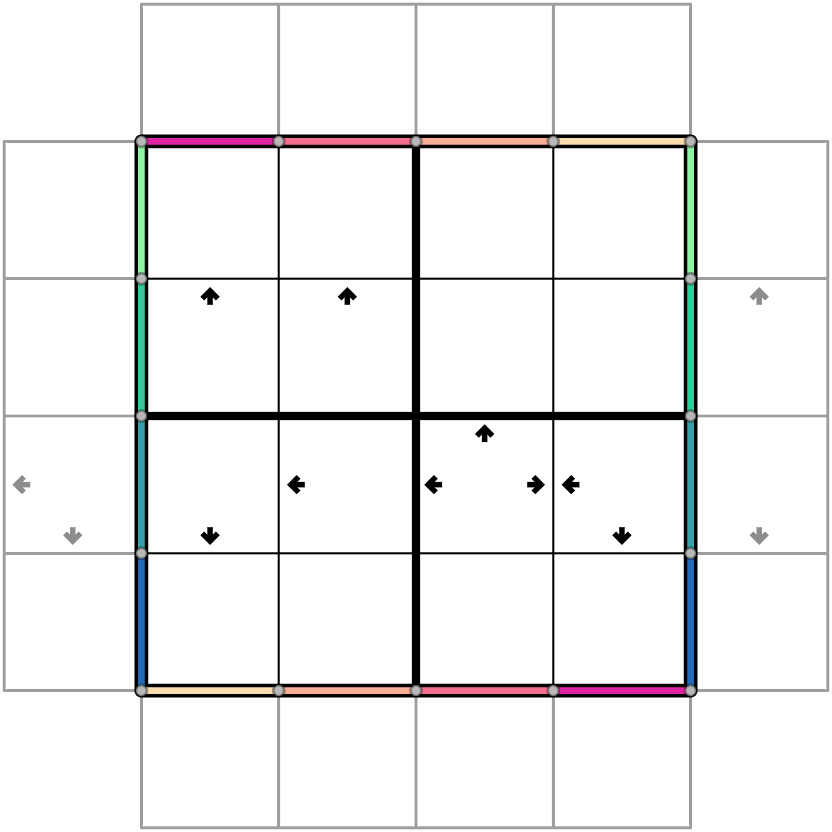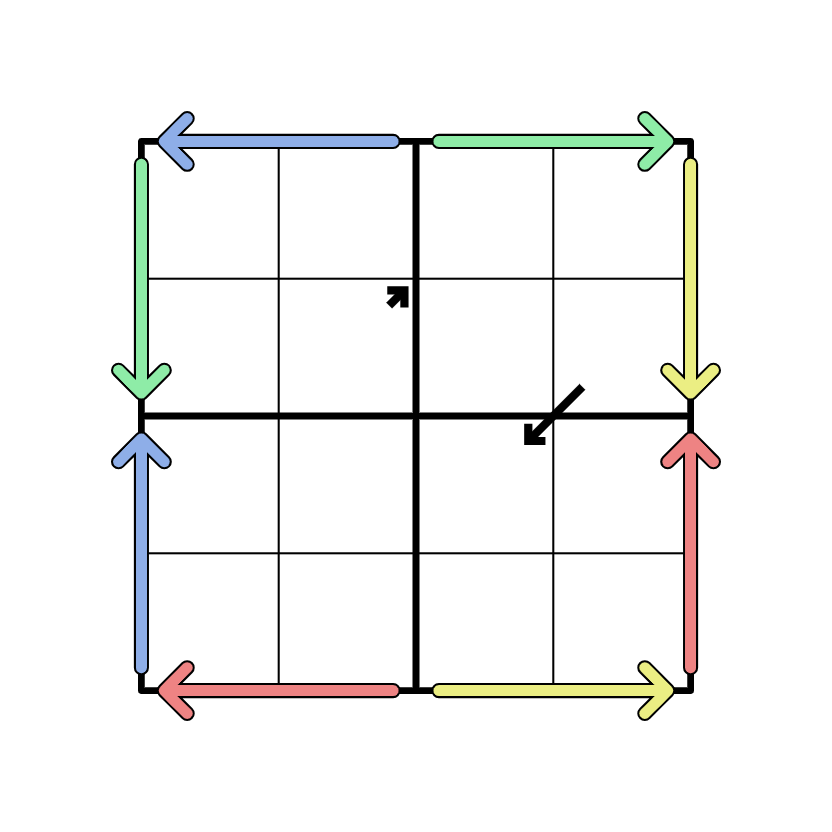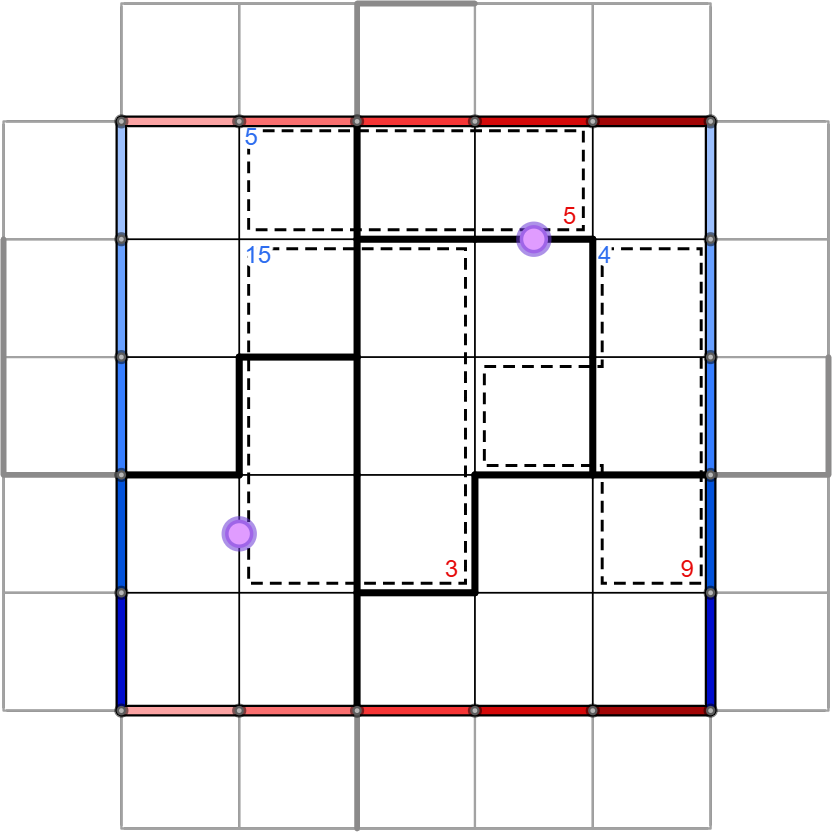Topological Snack Pack
(Eingestellt am 13. Mai 2025, 17:49 Uhr von DubiousMobius)
As a puzzler, I've always been drawn to exploring grids that wrap, tile, and twist in unusual ways. I know they can be intimidating to get one's head around, but I think they often provide the opportunity to ask questions that often don't exist on a standard grid.
My intention with this pack is to provide a few small puzzles that use funky geometry and rulesets, but where the solve path isn't monstrously difficult. Click the puzzles to play, and hope you enjoy!
1. Klein's Thimble

Place the digits 1-4 in each row, column, and box in the 4x4 sudoku grid.
Twisted Space: The grid behaves like a Klein bottle. The left and right edges wrap around, and are considered adjacent. The top and bottom edges wrap as well, but also undergo a twist, so that r1c1 is adjacent to r4c4, and r1c2 is adjacent to r4c3, etc. The border coloring reflects this.
Yin and Yang: Shade some cells in the grid so that the shaded and unshaded cells each form an orthogonally connected set. No 2x2 region of the grid may be entirely shaded or unshaded. This includes 2x2 regions that wrap around.
Sightline Arrows: The digit in a cell with an arrow counts the total number of cells belonging to its yin or yang region in the direction the arrow points before reaching a cell of the opposite shading, starting with the cell containing the arrow. If a cell has more than one arrow, it will see that many cells in every indicated direction, rather than collectively.
A moat has been provided for taking notes. Clues in the moat are duplicates of the clues in the grid, and are included to help track the grid geometry.
If you enjoy this puzzle, you might also like a bigger bottle.
2. The Longshot

Place the digits 1-4 once each in every row, column, and 2x2 box.
Genus 2 Grid: The grid has the topology of a double torus. Its borders wrap around as diagramed by the colored arrows. For example, the two cells at the back of a yellow arrow neighbor each other with the arrow as their border.
Shady Friends: Shade one cell in each 2x2 box. The shaded cell must be friendly, i.e. the digit placed inside must be equal to its row, column, or box.
Sightline Arrows: Digits placed on a black arrow count the number of unshaded cells that are seen in that direction prior to seeing a shaded cell. They start counting with the rearmost cell of the arrow.
A two-cell arrow is a two digit number with the arrow's back cell acting as the tens digit and the arrow's front cell acting as the unit digit.
3. Galactic Contraction

Place the digits 1-5 once each in each row, column, and region.
Galaxies: Draw two spiral galaxies in the grid, one 'red-shifted', and one 'blue-shifted'. The circles indicate the centers of the galaxies. Each galaxy is a set of orthogonally connected cells with rotational symmetry.
Cages: Digits may only repeat in cages if they belong to different galaxies. A blue number in the top left cell of a cage indicates the sum of all the blue-shifted cells in that cage. A red number the bottom right cell of a cage indicates the sum of all red-shifted cells in that cage.
Twins: Both galaxies have the same shape (i.e. it is possible to overlay one galaxy on the other through a combination of rotation, translation, and reflection). Every cell in the grid is part of exactly one galaxy, except for one cell, which belongs to neither. No 2x2 region of the grid belongs entirely to one galaxy.
Curved Space: The grid is toroidal, so a galaxy may wrap from the top row to the bottom, or the first column to the last and be considered orthogonally connected.
A moat has been provided for taking notes.
If you enjoy this puzzle, you might also like an expanded universe.
All feedback, whether complimentary or critical is always appreciated, and thanks for playing!
My intention with this pack is to provide a few small puzzles that use funky geometry and rulesets, but where the solve path isn't monstrously difficult. Click the puzzles to play, and hope you enjoy!
1. Klein's Thimble
Place the digits 1-4 in each row, column, and box in the 4x4 sudoku grid.
Twisted Space: The grid behaves like a Klein bottle. The left and right edges wrap around, and are considered adjacent. The top and bottom edges wrap as well, but also undergo a twist, so that r1c1 is adjacent to r4c4, and r1c2 is adjacent to r4c3, etc. The border coloring reflects this.
Yin and Yang: Shade some cells in the grid so that the shaded and unshaded cells each form an orthogonally connected set. No 2x2 region of the grid may be entirely shaded or unshaded. This includes 2x2 regions that wrap around.
Sightline Arrows: The digit in a cell with an arrow counts the total number of cells belonging to its yin or yang region in the direction the arrow points before reaching a cell of the opposite shading, starting with the cell containing the arrow. If a cell has more than one arrow, it will see that many cells in every indicated direction, rather than collectively.
A moat has been provided for taking notes. Clues in the moat are duplicates of the clues in the grid, and are included to help track the grid geometry.
If you enjoy this puzzle, you might also like a bigger bottle.
2. The Longshot
Place the digits 1-4 once each in every row, column, and 2x2 box.
Genus 2 Grid: The grid has the topology of a double torus. Its borders wrap around as diagramed by the colored arrows. For example, the two cells at the back of a yellow arrow neighbor each other with the arrow as their border.
Shady Friends: Shade one cell in each 2x2 box. The shaded cell must be friendly, i.e. the digit placed inside must be equal to its row, column, or box.
Sightline Arrows: Digits placed on a black arrow count the number of unshaded cells that are seen in that direction prior to seeing a shaded cell. They start counting with the rearmost cell of the arrow.
A two-cell arrow is a two digit number with the arrow's back cell acting as the tens digit and the arrow's front cell acting as the unit digit.
3. Galactic Contraction
Place the digits 1-5 once each in each row, column, and region.
Galaxies: Draw two spiral galaxies in the grid, one 'red-shifted', and one 'blue-shifted'. The circles indicate the centers of the galaxies. Each galaxy is a set of orthogonally connected cells with rotational symmetry.
Cages: Digits may only repeat in cages if they belong to different galaxies. A blue number in the top left cell of a cage indicates the sum of all the blue-shifted cells in that cage. A red number the bottom right cell of a cage indicates the sum of all red-shifted cells in that cage.
Twins: Both galaxies have the same shape (i.e. it is possible to overlay one galaxy on the other through a combination of rotation, translation, and reflection). Every cell in the grid is part of exactly one galaxy, except for one cell, which belongs to neither. No 2x2 region of the grid belongs entirely to one galaxy.
Curved Space: The grid is toroidal, so a galaxy may wrap from the top row to the bottom, or the first column to the last and be considered orthogonally connected.
A moat has been provided for taking notes.
If you enjoy this puzzle, you might also like an expanded universe.
All feedback, whether complimentary or critical is always appreciated, and thanks for playing!
Lösungscode: Column 2 from puzzle 1 with a / between cells of opposing yin yang regions (e.g. 1/23/4). Then the digit in the shady cell seen by the short arrow in puzzle 2. Finally, digit in the neutral cell from puzzle 3.
Gelöst von Yiab, tuturitu, jkuo7, WvdWest, aqjhs, DiMono, tnop62830, Smartacus
Kommentare
am 13. Mai 2025, 20:11 Uhr von Yiab
Very well done.



